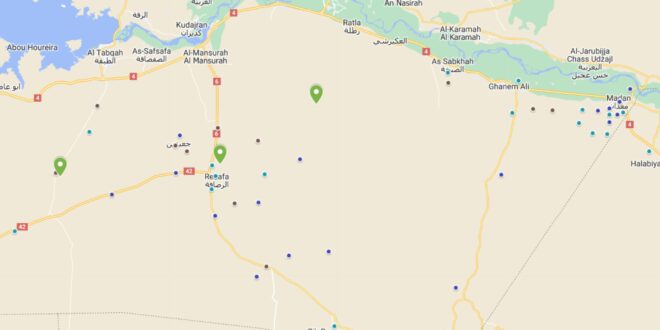ISIS carried out at least 12 confirmed attacks in October in the Homs, Hama, Raqqa, and Deir Ez Zor governorates. These attacks killed at least 20 pro-Assad regime soldiers and one civilian and wounded at least 24 others. There were also three high quality* attacks carried out during the month. ISIS attacks in central Syria have now declined for two months in a row, dropping to their lowest point since September 2023. October continued September’s trend of ISIS attacks primarily focused on security forces, rather than local civilians. However, unlike in September, October’s attacks were overwhelmingly conducted with mines or improvised explosive devices (IEDs), rather than aggressive small arms attacks on regime patrols or fixed positions. The combined decrease in activity and the shift to a more passive stance has historically signaled the beginning of a period of reduced ISIS activity. Furthermore, the group may be suffering from the double blow of heavy regime operations in September and early October, and three sets of U.S. airstrikes targeting ISIS training camps in the Badia, on September 16, October 12 and October 28 which killed at least 63 militants.
Nonetheless, ISIS was still able to carry out several significant attacks in October. Militants conducted a complex ambush on a small convoy in southern Raqqa late in the month, first capturing a nearby outpost and then hitting the convoy, killing six soldiers and destroying three trucks. ISIS fighters may have also been responsible for the deaths of two Syrian regime generals and a senior Russian officer in Deir Ez Zor. However, local journalist Zain al-Abidin, who also tracks ISIS attacks closely, believes that the men were actually killed in U.S. airstrikes east of Deir Ez Zor city that day. U.S. forces repeatedly shelled regime positions in Deir Ez Zor throughout October in response to continuous attacks against the U.S. and their Kurdish ally’s bases in the area. All three officers were reported killed on the same day in the Deir Ez Zor countryside, with pro-regime and Russian media making no reference to who was behind the killings. Similarly, there were at least three more pro-regime fighters killed in Deir Ez Zor in October, all by explosives planted in their vehicles. According to Zain al-Abidin these attacks are likely the result of “score settling” between various regime factions and not related to ISIS.
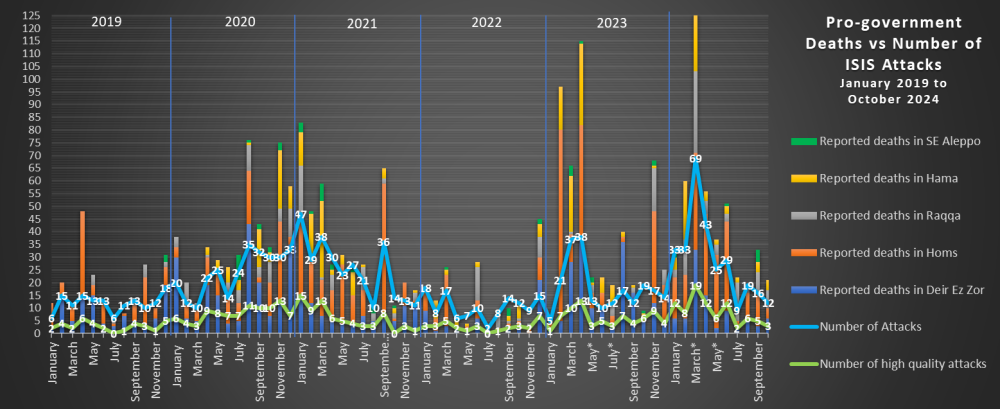
*Indicates attacks in Damascus City claimed by ISIS. Additional IED attacks occurred in Homs City in June 2023 and in Damascus in March 2024 and May 2024 that went unclaimed but were suspected to be conducted by ISIS.
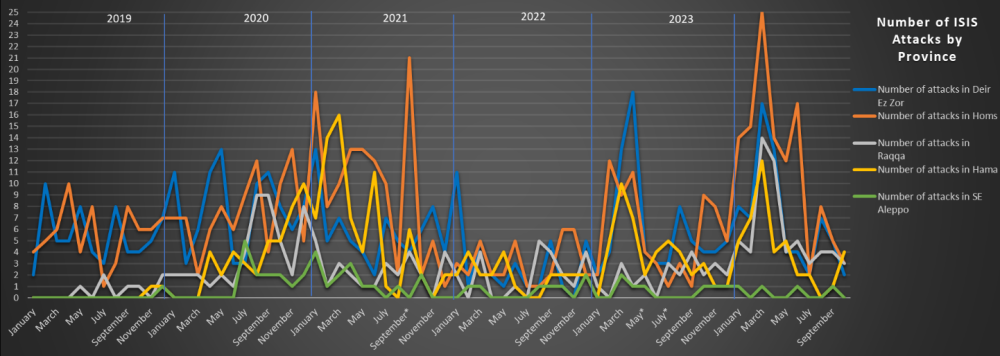
Confirmed ISIS attacks increased for the first time in five months in Hama (4), while dropping slightly in Deir E Zor (2), Homs (3), Raqqa (3), and Aleppo (1).
Deir Ez Zor and Raqqa
ISIS expanded its low-level insurgency within the urban belt of Deir Ez Zor in January, when it conducted three assassinations of local security forces. Sleeper cells continued this trend through April, conducting nine urban assassinations inside Mayadin City. In May, regime security forces captured a small four-man ISIS cell inside Mayadin. According to local journalist Zain al-Abidin, three of the detained men were serving in the pro-regime National Defense Forces (NDF) and their leader had entered Mayadin from northeast Syria during the regime’s 2022 reconciliation initiative – a security risk this author highlighted at the time. Between June and August, ISIS assailants conducted an IED and three small arms attacks across Deir Ez Zor City, Shamitiyah, and Mayadin City. However, there were no documented urban attacks in Deir Ez Zor in September or October.
On October 1, a soldier was killed by a mine or IED in the Boukamal countryside, in southern Deir Ez Zor. On October 12, two Syrian brigadier generals and a Russian colonel were killed in Deir Ez Zor. There were no credible reports on where exactly they were killed, or how, but they were likely killed in a targeted IED attack given the fact that no other security forces were killed along with them. This attack comes two weeks after ISIS cells in eastern Homs killed a Syrian lieutenant colonel and major in a targeted IED attack. It is the first Russian officer killed in central Syria since September 2021.
In Raqqa, ISIS activity in May fell to more typical levels following two months of heightened activity. Since then, the group has maintained a low-level but robust insurgency in the desert between Resafa and Jabal Bishri. This trend continued through October, while attacks also expanded westward towards the Tabqa countryside. In fact, according to Zain al-Abidin, in late October two ISIS fighters were killed by a landmine west of Tabqa airport while attempting to reach the base to conduct an attack.
On October 24 two soldiers were killed by a landmine in the Resafa countryside. On October 29, ISIS militants conducted a complex ambush against a convoy traversing the desert northeast of Resafa, traveling between the oil fields and the urban belt along the Euphrates River. Militants first attacked a military point, killing two soldiers, before then ambushing the convoy of civilians and soldiers. Four more soldiers and a driver were killed while five civilians were wounded. ISIS fighters were able to burn down three trucks in the attack. Two days later, militants attacked an outpost of the regime’s 5th Corps near the Thawra Oil Field, 25km west of Resafa, wounding two soldiers.
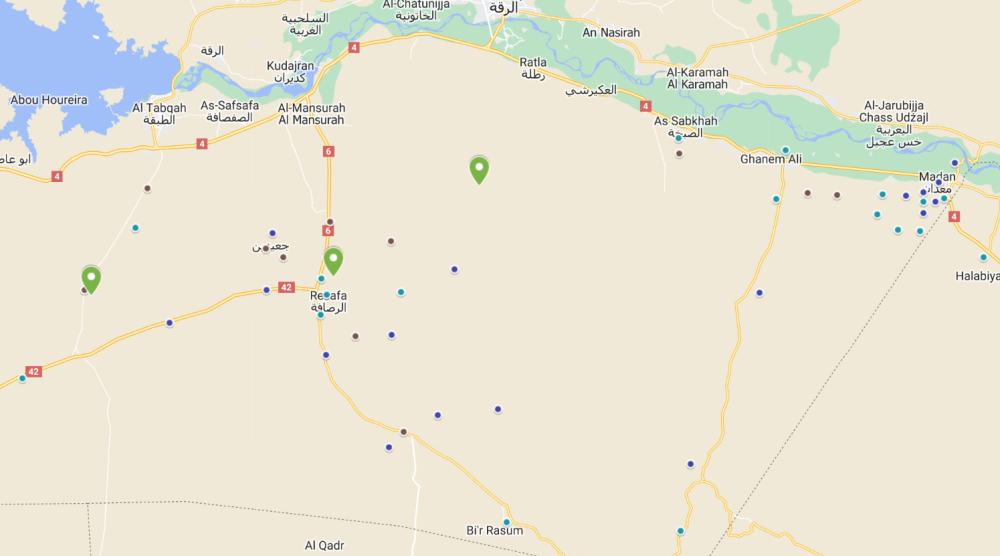
Map of locatable ISIS attacks in Raqqa (green pins) in October 2024 alongside all other attacks in 2024.
Homs
ISIS activity in eastern Homs decreased in December 2023, but remained focused around the Doubayat Oil Field, which the group had temporarily captured in November. Most ISIS activity was concentrated in this area in January 2024, though the group also expanded operations west into the desert just south of Palmyra and Arak. By February, ISIS largely abandoned the southern Palmyra front, likely because of pro-regime ground and air operations, d shifting its focus to the Taybeh sector north of Sukhnah and the Jubb Jarah mountains north of Palmyra. This focus continued into March, with activity remaining concentrated in the Sukhnah-Taybeh-Kawm axis in both April and May. However, security forces continued to largely stand their ground and in June, ISIS responded by once again shifting its attacks to the Jubb Jarah and southern Wadi Doubayat-Palmyra region, seemingly abandoning the Taybeh-Kawm front. The deployment of significant numbers of Russian-backed 25th Division fighters in early June and those subsequent battles appear to have resulted in ISIS largely abandoning all eastern Homs fronts in July. In August, ISIS renewed its violent activity in eastern Homs, but largely avoided the core Palmyra-Sukhnah region, likely now too heavily fortified for the group to risk attacking. This continued in September, with attacks primarily occurring in the northeast of the governorate.
On October 11, a soldier was killed by a mine or IED in the mountains between Palmyra and Tuwaynan, where ISIS has long maintained a presence. On October 18, a member of the pro-regime Liwa al-Quds Mountain Forces was killed near Taybeh. On October 24, two more soldiers were killed in a small arms ambush east of Sukhnah.
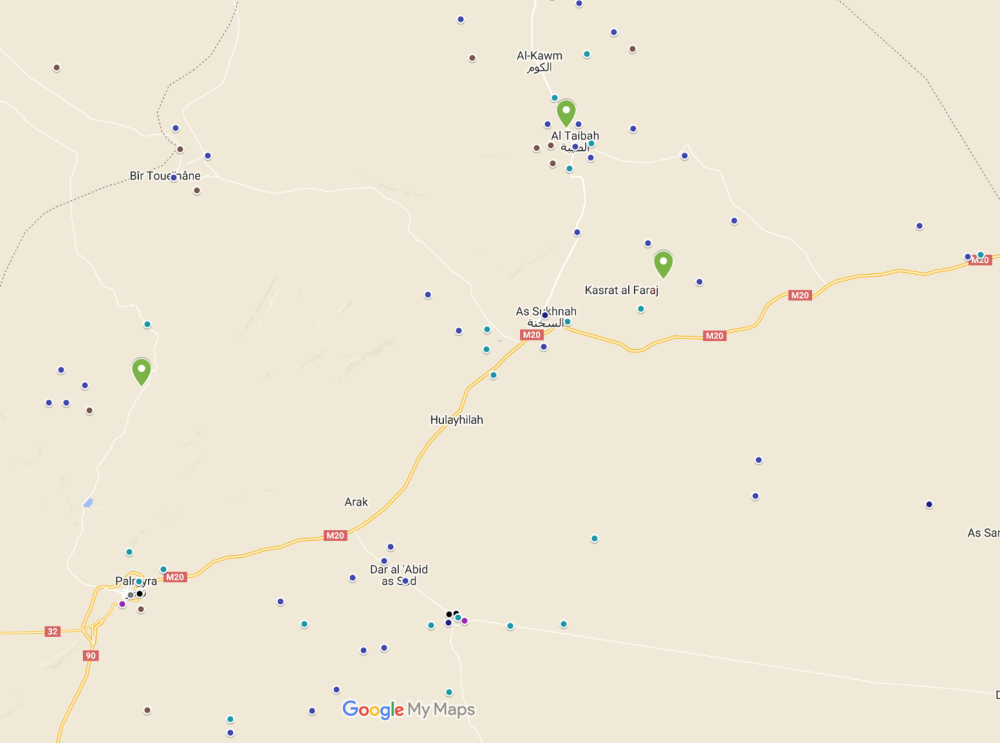
Map of locatable ISIS attacks in Homs (green pins) in October 2024 alongside all other attacks in 2024.
Hama and Aleppo
Significant ISIS activity returned to east Hama in January, when the group conducted five attacks, three being high quality. Likewise, ISIS conducted three high quality attacks in eastern Hama in February. This was the first time eastern Hama had witnessed back-to-back months of three or more high quality attacks since spring 2021. In March, there were five high quality and 12 total attacks, almost all against security forces. However, activity fell significantly starting in April, with only intermittent incidents occurring through the end of September.
ISIS activity returned in October, though all incidents involved mines or IEDs. On October 24, a mine or IED hit a military vehicle driving east of Uqayribat, killing four Special Forces soldiers and wounding 10 others. On October 27, two soldiers were wounded by a mine or IED near Tel Salama, north of Uqayribat, while two others were wounded near Tuwaynan, east of Uqayribat, along the Homs-Hama border. On October 28, two more soldiers were wounded by another mine or IED near Tel Salama.
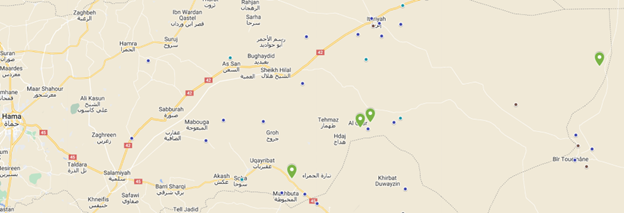
Map of locatable ISIS attacks in Hama (green pins) in October 2024 alongside all other attacks in 2024.
Looking Ahead
July marked the end of what can be categorized as ISIS’s first sustained Badia campaign since 2020. Beginning with a localized but significant escalation in October 2023 and culminating in a sustained region-wide series of campaigns throughout much of 2024, ISIS showed a renewed energy and strength after years of concentrated regime operations. Still, the regime and its Russian and Iranian allies were able to effectively secure all the critical sites across the region, preventing ISIS from making any permanent gains. Key to this success was the deployment of core regime units that had never before participated in the counter-insurgency campaign.
Despite a spike in attacks in August – and a spike in ISIS-caused deaths in September – ISIS activity in central Syria appears to be on a slight downward trend. As previously noted, this suppressed activity likely stems from multiple factors: 1) Increased regime manpower and combing operations limiting ISIS’s ability to easily ambush weak outpost or patrols; 2) U.S. airstrikes in September and October, destroying training camps and killing fighters and leaders; 3) ISIS cells requiring down-time after many months of sustained high-tempo operations, and; 4) ISIS leadership continuing to prioritize operations in northeast Syria, and therefore shifting resources out of central Syria.
Two of these factors are tied to pressure from counter-ISIS operations by both regime-aligned forces and the U.S. Coalition. It is possible that if pressure from both of these entities can be sustained, we may see an extended period of reduced ISIS activity. However, on- the-ground reports from central Syria suggest that ISIS still maintains a high degree of freedom of movement throughout the desert. At best, what we are currently seeing is a – likely temporary – equilibrium where ISIS cells are able to move freely through ‘their’ territory, while regime positions have largely been secured. In other words, the cost of aggressive, high quality attacks right now is too high for ISIS, and so the group has shifted back to a more passive or defensive posture while it refits its cells and possibly shifts resources between the northeast and central Syria fronts. But this is a dynamic we have seen many times in the past; as always, the group will simply wait for the array of anti-ISIS forces in the region to let up on the pressure and then retake the offensive.
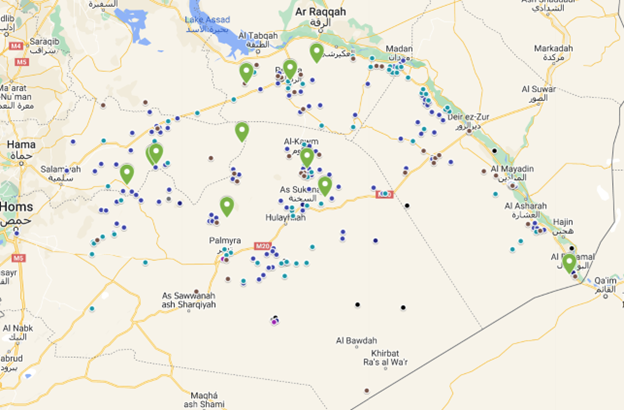
Map of locatable ISIS attacks (green pins) in October 2024 alongside all other attacks in 2024. Not mapped is one attack which occurred somewhere in the Deir Ez Zor countryside.
*High quality attacks are defined as attacks behind frontlines, attacks that result in seized positions, target regime officers, or involve coordinated attacks on multiple positions, “flying checkpoints” (temporary roadblocks ISIS fighters establish in order to stop and extort or ambush a few cars), ambushes on military convoys, or attacks on checkpoints that kill at least three soldiers or lead to POWs.
 Eurasia Press & News
Eurasia Press & News
